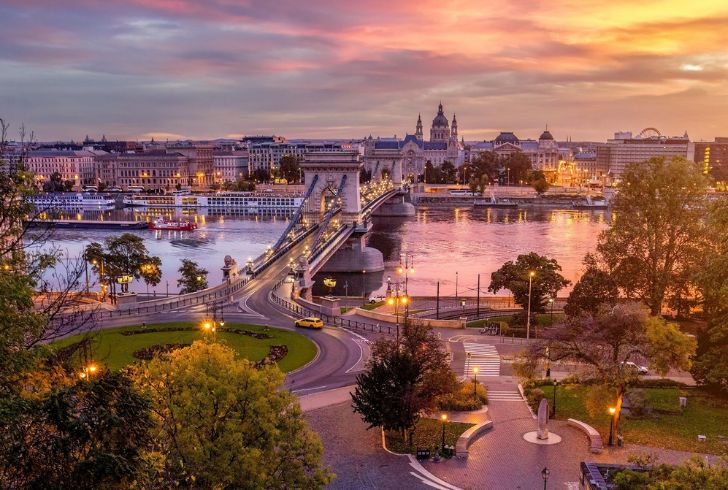
How Much Does It Cost to Travel in Europe?

Dreaming of strolling along the Seine in Paris, exploring ancient ruins in Rome, or sipping sangria on a Spanish beach? Europe’s diverse cultures, rich history, and stunning landscapes make it a top destination for travelers worldwide. But before you pack your bags, you’re probably wondering – how much does it cost to travel in Europe?
Let’s break it down and help you plan your perfect European adventure, no matter your budget.
European Travel – A Continent of Contrasts
Europe’s 44 countries offer a kaleidoscope of experiences, from bustling metropolises to quaint villages, snow-capped mountains to sun-soaked Mediterranean coastlines. This diversity extends to travel costs as well. While some regions can put a strain on your wallet, others offer incredible value for money.

Instagram | visit_europe | Europe countries present a vibrant mix of bustling cities, charming villages and snowy peaks.
Factors Influencing Your European Travel Budget
• Destination – Eastern Europe tends to be more budget-friendly than Western or Northern Europe.
• Travel style – Are you a hostel-hopping backpacker or a luxury hotel connoisseur?
• Season – Peak summer months and holidays can significantly increase costs.
• Length of stay – Longer trips often allow for better deals and a lower daily average cost.
• Transportation choices – Budget airlines and rail passes can offer significant savings.
Breaking Down the Costs
Let’s explore three budget scenarios for a two-week European adventure:
The Savvy Backpacker (€1,120 – €1,400)
• Accommodation – Hostels, budget guesthouses, or work exchanges (€15-€25/night)
• Food – Mix of grocery shopping, street food, and occasional cheap eats (€25-€35/day)
• Transportation – Public transit, budget airlines, occasional ride-shares (€8-€12/day)
• Activities – Free walking tours, museums on discount days, nature excursions (€15-€25/day)
Pro tip – Consider work exchanges through platforms like Workaway or WWOOF to slash accommodation costs and gain unique local experiences.
The Comfortable Mid-Range Traveler (€1,960 – €2,500)
• Accommodation – Mix of budget hotels and nicer hostels (€35-€60/night)
• Food – Local restaurants, cafes, with occasional splurges (€35-€50/day)
• Transportation – Mix of public transit and occasional taxis or car rentals (€15-€25/day)
• Activities – Paid tours, attractions, and shows (€40-€60/day)
The Luxury Seeker (€5,320+)
• Accommodation – 4-5 star hotels or upscale vacation rentals (€180-€300+/night)
• Food – Fine dining, trendy restaurants, and drinks at swanky bars (€70-€100+/day)
• Transportation – Taxis, private transfers, first-class train travel (€25-€50+/day)
• Activities – Private guided tours, exclusive experiences, high-end shopping (€60-€100+/day)
Remember these are rough estimates. How much does it cost to travel in Europe can vary widely based on your specific choices and destinations.
Money-Saving Tips for European Travel

Instagram | visithungary | Hungary boasts breathtaking landscapes, rich history, and lively cultures, all at a fraction of the cost of Western Europe.
1. Visit Eastern Europe
Hungary, Czech Republic, and Romania offer stunning landscapes, rich history, and vibrant cultures. Plus, they’re incredibly budget-friendly compared to Western Europe.
2. Travel off-season
Skip the peak summer months of July and August. Enjoy lower prices, smaller crowds, and potentially better weather in shoulder seasons like spring or autumn.
3. Get a rail pass
If you plan to explore multiple countries, a Eurail pass can save you money on train tickets. It’s a convenient and efficient way to travel.
4. Eat like a local
Immerse yourself in the local culture by trying street food and shopping at markets. Not only is it delicious, but it’s also a great way to save money.
5. Free walking tours
Discover the city’s highlights with knowledgeable local guides. These tours are typically free, but tipping is appreciated.
6. City tourist cards
Maximize your sightseeing with a city tourist card. Many include public transportation, museum entry, and other discounts.
Hidden Costs to Consider
Don’t forget to factor in these potential expenses when budgeting:
• Visas (if applicable)
• Travel insurance
• International transaction fees on credit cards
• Souvenirs and shopping
• Emergency fund (always a good idea!)
Your European Adventure Awaits!
Now that you have a clearer picture of potential costs, it’s time to start planning your dream European getaway. Remember, there’s no one-size-fits-all answer to how much does it cost to travel in Europe. The beauty of this diverse continent is that it offers something for every budget and travel style. So pack your bags, brush up on your phrase book, and get ready for the adventure of a lifetime!
More in Lifestyle
-
`
Mahershala Ali and Amatus-Sami Karim’s Decade-Long Marriage
Who is Mahershala Ali married to? This question often arises when discussing the acclaimed actor. Mahershala Ali, the talented and versatile...
August 5, 2024 -
`
Is It Normal to Be Sore After a Massage? 9 Ways to Relieve Soreness
Is it normal to be sore after a massage? Many people schedule a massage to drift into a state of relaxation...
August 3, 2024 -
`
Delicious Pescatarian Breakfast Ideas
Exploring new breakfast ideas can be a delightful way to start your day, especially when they align with a pescatarian diet....
July 24, 2024 -
`
Is Phuket Worth Visiting in 2024?
Phuket, Thailand’s gem of an island, has long attracted travelers with its pristine beaches, lively nightlife, and cultural treasures. The question...
July 19, 2024 -
`
What is the Best Way to Melt Chocolate for Any Recipe?
Chocolate is a beloved ingredient in many desserts, from ganache and cake batters to decadent drizzles over ice cream. Knowing what...
July 12, 2024 -
`
How to Plan a Backpacking Trip Like a Pro in 16 Steps
Planning a backpacking trip can be as thrilling as it is daunting, especially if you’re keen to make every moment count....
July 5, 2024 -
`
How to Build Fast-Twitch Muscles in 5 Simple Steps
Have you ever wondered how to build fast-twitch muscles? These powerful muscle fibers are key to explosive strength and speed. Whether...
June 20, 2024 -
`
How to Create the Perfect Goulash Recipe Every Time
As autumn leaves paint the landscape in warm hues, nothing complements the chill in the air quite like a bowl of...
June 15, 2024 -
`
Fun Things to Do When Bored With Friends
When boredom strikes, especially when you are with friends, it is easy to fall into the trap of mindlessly scrolling through...
June 4, 2024















You must be logged in to post a comment Login